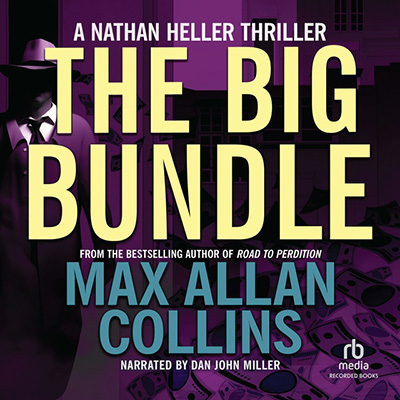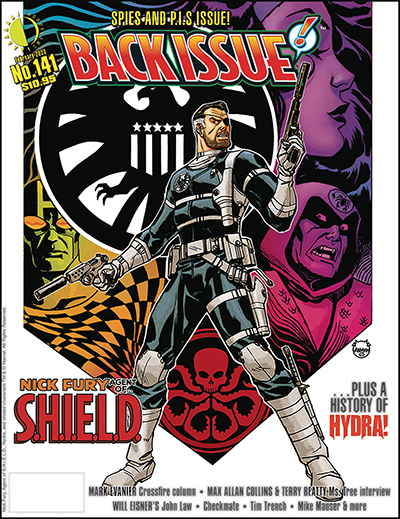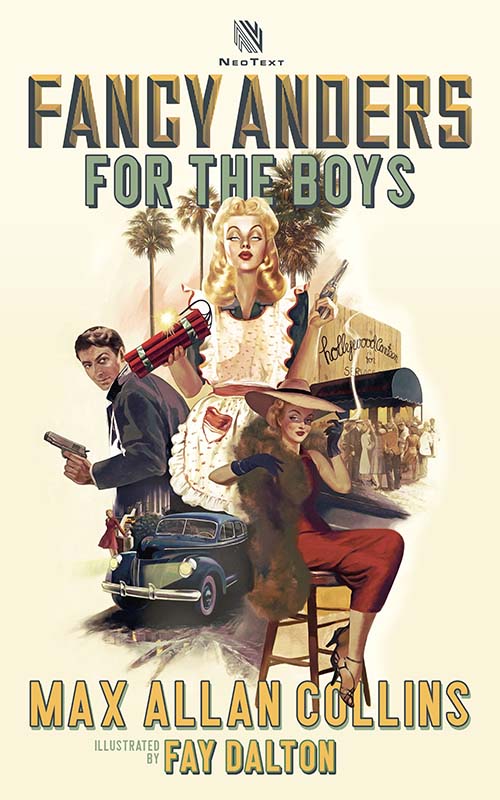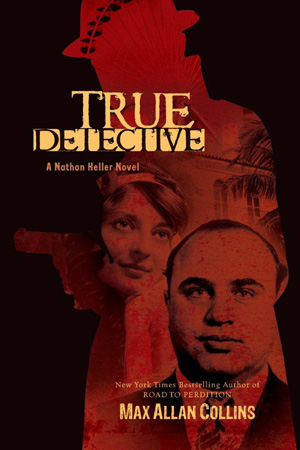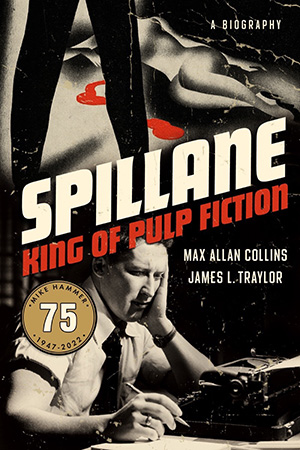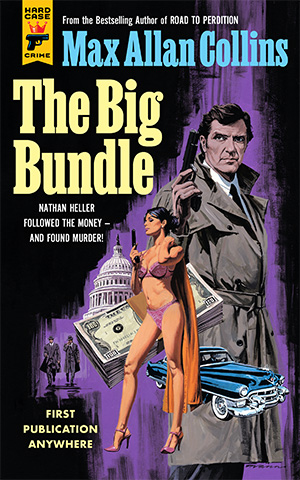An in-depth Ms. Tree-centric interview with Terry Beatty and me appears in issue #141 of Backissue magazine (“SPIES AND P.I.S ISSUE!”). It proves beyond a shadow of a doubt that Terry’s memory is better than mine (a low bar, eh, Terry?). Thank you to interviewer Stephan Friedt for doing such a great and thorough job, and selecting images that show once and for all how good Terry Beatty is.
Backissue #141 with its beautifully laid out and illustrated article (we’re in the Mike Mauser article too) is available here.
* * *
Here is an advance review of The Big Bundle, the new Nate Heller. It’s from Deadly Pleasures, a long-running, very good mystery fanzine which I believe is strictly available as an e-zine now…or is it returning to print? I’ll check into that and get back to you.
In the meantime, here’s the review:
THE BIG BUNDLE by Max Allan Collins (Hard Case Crime, $22.99, December 2022) Rating: A
In 1953 six-year-old Bobby Greenlease is kidnapped. His wealthy parents call on the services of private investigator Nathan Heller, who had represented them in another matter some years earlier. Robert Greenlease insists on having the kidnapping of his son handled on his terms with as little interference from the FBI and police as possible. The kidnappers pick up the ransom, as scheduled, but Bobby is not returned. The kidnappers, however, assure the family that he’ll be back, safe and sound, within twenty-four additional hours. But then half of the $600,000 ransom disappears and things take a turn for the worse. Five years later Heller is called back to try to find the missing money. But Washington politics, Bobby Kennedy, and Jimmy Hoffa all manage to get tangled up with Heller’s efforts to help Greenlease once again.
All of the Heller novels are based in solid fact, thoroughly researched, with details of the characters and their eventual fates detailed at the conclusion of the story. Of course the real-life kidnapping of Bobby
Greenlease is nowhere near as well-known as the 1932 abduction and murder of the Lindbergh baby. Heller had investigated that crime, as well, in Max Allan Collins’ Stolen Away (1992). In spite of the outcome of that case, he is once again entrusted with finding and returning a missing child to his parents.
Collins is a master (actually an MWA Grand Master!) at finding a plausible method of inserting his long-running fictional detective into the events of the day. He does this by using actual places, events and real people such as Kennedy, Hoffa, Chuck Berry, and Drew Pearson to add authenticity to the narrative. In doing so Collins immerses the reader in the 1950s’ era lifestyle. What’s even more remarkable is that he’s been doing this for forty years, since his 1983 debut Heller novel, True Detective.
If you’ve never read a Heller novel, don’t be discouraged by the fact that this is the eighteenth book (plus a number of short stories) in the series. The chronicles are not published in any specific order, moving around in time from the days of Capone and Nitti to Monroe and the Kennedys. But this one, the first from Hard Case Crime, is as good a place to jump in as any other. Then you’ll want to go back to the 1920s and start with that first one in what is one of the finest historical crime novel series being published today.
Don’t know who wrote the review. Possibly editor George Easter himself. I’ll let you know when I know.
The Big Bundle is, according to Amazon, going to be available later this month (January 24). As it was officially (and actually) published in December of last year, this just about guarantees screwing me up for awards consideration, and of course the book was not read by most of the people who do year’s end “Best of” lists. This is not a plan to make my life miserable (I don’t think), just the books getting tied up in London in a dock strike.
The e-book has been available since the originally announced publication date, and I’m not sure about the audio book (read by the great Dan John Miller). I know the latter exists, because (like the hardcover edition) I’ve had the audio book since early December.
Sigh, as the great Charlie Brown frequently said.
But the Big Bundle reviews have been stellar so far, especially the starred Publisher’s Weekly, and (among others) Deadly Pleasures is a nice one, too, obviously.
A problem that few of you who stop by here will have is that a certain breed of dedicated mystery reader refuses to start reading a series with any entry but the first, and doggedly plows on ahead in order of publication. I am anal retentive enough to understand this. But it really hurts writers of a long-running series – it’s the sales and response to the current book in a series that determines whether there will be any more.
So when a reader who has (finally) decided to take a look at Nathan Heller (or any long-running series) feels obligated to start with the first book, he or she is actually decreasing the chances of that series continuing. The current entry’s sales dictate the future, or lack of one, for the series. My suggestion is: sample the current book, and if you like it, go back to the beginning. And in the case of Nathan Heller (and for that matter Quarry), keep in mind that the books were neither written nor published in chronological order.
At the beginning, the first four Heller novels were indeed written in chronological order, with the first three comprising the Frank Nitti Trilogy. But starting with Stolen Away (the fifth published Heller), I began jumping around – the famous unsolved (or controversially “solved” crime) at the heart of a Heller novel simply reflected what I was interested in writing about and/or what I could sell to an editor. So in Stolen Away (the longest entry in the saga), the novel begins before the first book (True Detective) and its last section takes place after the third book, True Crime. In fact, that last section of True Crime takes place after Blood and Thunder, as well. Confused yet?
This is bound to give the anal retentive among you a migraine. But in the case of Nathan Heller, you can’t easily read them in chronological order–Damned in Paradise, for example, takes place in the middle of Stolen Away! You have to read part of one book, move to another book, then come back again to the previous one you began.
Reading the books in the order in which they were written makes more sense, but not much. The danger for me is that some readers might skip a Heller because the famous case my guy is working on is not of particular interest to them. Then that reader has got out of the habit of reading Heller.
The Big Bundle is an unusual Heller in one sense: the famous crime (the Greenlease kidnapping) at its center is not as famous as it once was. Everybody remembers the Lindbergh baby, but few recall little Bobby Greenlease. The narrative does involve Jimmy Hoffa and Bobby Kennedy.
Interestingly, I get occasional complaints from readers who stay away from Heller – or have read one or two and bail on the series – because they can’t accept one private detective being involved in so many famous crimes. These are the kind of people who have no problem with Perry Mason handling 100 murder cases and Archie & Nero solving seventy-some murder mysteries. People! Take the ride.
The Greenlease case got on my radar a long, long time ago, and I knew I would get around to it. It’s frustrating to me that the book was published when it was – December books (which, as I say, The Big Bundle is – pub date is December 2022) – tend to fall between the cracks where Best of the Year lists are concerned. Not the reader/reviewers fault: they can only reflect back on what they’ve been able to read.
A few have. Reviewers who received ARCs or e-mail galleys have included The Big Bundle perhaps three or four times on best of year’s end lists. But it’s frustrating. It’s hard enough to get anybody to sing about a book in a long-running series without the music falling between the cracks of the piano.
And then there’s the Edgars – it’s tough enough under good circumstances to get acknowledged in that field of competition. But the confusion of a book published in December but not widely available till late January seems a guarantee for no attention at all.
I am not alone. Any writer who has a book published in December is up against it. Actually, any writer who has a book published in January (and the next few months) is, too. People have shorter memories than they do attention spans. Quarry’s Blood got fabulous reviews but it was published in February ‘22 and I don’t know a single year’s end best of list it made. (If you know of one, give me a shout.)
Why do you suppose is that there’s such a prejudice against long-running series in awards consideration? In many cases, it’s other mystery writers (many of whom write series) doing the judging. As fans of the mystery genre, we bow to the likes of Rex Stout, Sir Arthur Conan Doyle, Agatha Christie, Raymond Chandler, Erle Stanley Gardner, and Dorothy Sayers, who devoted themselves (well, Doyle reluctantly) to series that ran a good long while. Today, series entries are routinely ignored in awards consideration. Publishers scrap-heap series, even long-running ones, to make room for new series (which are also doomed to be dropped after an entry or two, because no publisher today wants to spend their time building a series).
I don’t know that anything can be done about any of this. Call me a whiner (and I certainly am!) but it’s a frustration that many mystery writers…perhaps most…feel from time to time.
* * *
The second of the three Fancy Anders short novels is soon to appear (March 7), Fancy Anders for the Boys. I just did the proof read on the galleys and was very pleased. The art, again by the great Fay Dalton (the cover and one full-page illo for each of the ten chapters) is superb. This week you get a look at the stunning cover Fay provided.
The Fancy Anders novellas are primarily e-books, but Neo Text (who continue to be wonderful to work with) does a short print run followed by POD, so you physical media types (like me) can have an actual book version.
The advantage of the e-book over print is that Fay’s art is mostly in color and you get gray tones in the print version. The three short novels (which I wrote back-to-back during the Covid lockdown) were designed to tell one long story in the fashion of serialization that the pulp Black Mask indulged in – with Hammett’s The Dain Curse, for example, which told three stories each of which resolved but also intertwined into what is now seen as a novel.
The end game is going to be to find a publisher who will do all three books in a larger format with the illos in full color (a few have limited color) and that it will be seen as the novel I always intended.
I loved doing this project and adore Fancy and relish the ‘40s period. I hope I get to do more, though in what format I have no idea (yet).
* * *
Some of you may recall that I have at times in interviews I’ve mentioned the impact of certain writers (Alexandre Dumas père, author of Three Muskateers and its sequels, for example) of historical fiction on the true-crime based Nathan Heller novels. The name I cite most prominently is Samuel Shellabarger, author of two of my favorite books (and movies), Captain from Castille and Prince of Foxes. Shellabarger wrote several more novels in this vein, and a few other things (he died rather young, at least young by my standards), but I recently – to my delighted surprise – learned that he had started out as a mystery writer.
He was also an academic and scholar, so he published under pen names: John Esteven and Peter Loring. I have begun picking his mystery novels up, when I can afford them – they don’t run cheap – and I’m reading one now. Graveyard Watch (1938) by Esteven isn’t very good, though, and I’m hopeful others of Shellabarger’s mysteries are better.
This one is in first-person with an Irish-American narrator whose brogue drips off the page. Among other things, Shellabarger was a linguist, so this reflects an interest of his, but it doesn’t make the read any smoother. And he reports an accent from an Asian woman that I can’t begin to decipher (both the accent and the woman).
I will try others by him, though, because learning of Shellabarger’s mystery writer roots, I suddenly felt like I’d found a kindred spirit. Heller is definitely in the vein of Shellabarger’s fictional heroes who find themselves smack in the middle of non-fictional history.
Read about him here.
* * *
Here’s a nice write-up on the forthcoming Classic Flix release of The Long Wait (with my commentary).
Finally, the best crime comics are selected here (check out #8).
M.A.C.
